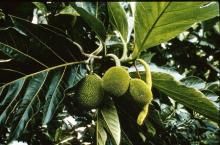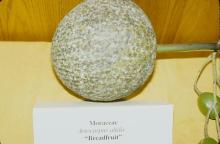Maturity and Quality
Fully mature fruits are dark-green and their segments are more rounded and smoother than less mature fruits. Latex stains may be present on the skin of mature fruits. Yellowing of the skin indicates over-maturity (partial ripeness). In some cases, fruits are picked when fully ripe and sweet for consumption as a dessert.
- Good quality breadfruits are mature-green, firm, with intact stem, and free from defects (such as blemishes, sunscald, cracking, bruising, and insect damage) and decay
- Uniformity of shape, size, and weight is also important as quality factors
- Breadfruit pulp (edible portion) contains 25-30% (fresh weight basis) carbohydrates, half of which is starch. The pulp is boiled, baked, fried, or roasted, but never eaten raw. It is also ground into flour that is used in bread-making
Postharvest Handling and Storage
13 ± 1°C (56 ± 2°F)
Storage potential = 2-4 weeks, depending on cultivar and maturity stage.
The range of respiration rates at 20°C (68°F) is 38 (preclimacteric) to 178 (climacteric peak) ml CO2/kg·hr.
To calculate heat production multiply ml CO2/kg·hr by 440 to get Btu/ton/day or by 122 to get kcal/metric ton/day.
Exposure to 50ppm or higher concentrations of C2H4 for 24 hours at 20°C (68°F) accelerates ripening of breadfruits (as indicated by color changes from green to yellow and softening) and shortens their postharvest-life.
85-95%
The range of ethylene production at 20°C (68°F) is 0.1 (preclimacteric) to 1.6 (climacteric peak) µl/kg·hr.
A CA of 5% O2 + 5% CO2 or use of modified atmosphere packaging (5-8% O2 + 8-10% CO2) may be useful in delaying ripening (softening) and extending postharvest-life of mature-green breadfruits kept within the optimum ranges of temperature and relative humidity.
Disorders
Chilling Injury. Fruits kept at temperatures below 12°C (54°F) before transfer Disorders to higher temperatures exhibits the following symptoms of chilling injury: brown discoloration of the skin, pulp browning and off-flavor development, and increased susceptibility to decay.
Pathological disorders usually follow mechanical damage and/or chilling injury of breadfruits. Decay may be caused by Phytophthora palmivora or Rhizopus artocarpi or Botryobasidium salmonicola.





